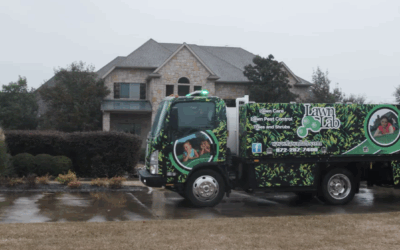Rise of the Robo-Mower: How AI, Immigration, and HOAs Are Reshaping the American Lawn
KEY TAKEAWAYS
- 80% of Gen Z homeowners are ready to embrace AI lawn tools.
- Nearly 50% of homeowners fear Trump-era immigration policies will drive up lawn care costs.
- 54% of Americans would switch to AI lawn tools — as long as it saves them money.
- 48% believe AI lawn tools are rising in popularity due to immigration restrictions.
- 62% of homeowners don’t care if their landscaper is undocumented.
- Urban homeowners are 58% more likely to consider AI lawn tools than rural residents.
- 1 in 5 Gen Z homeowners already use robotic mowers.

Lawn care has come a long way since the invention of the mechanical mower. Modern landscapers now turn to technologies like artificial intelligence (AI) tools and lawn care software to optimize their mowing routines.
But is the age of smart lawn care winning over homeowners — or raising eyebrows? We asked 1,000 Americans how they really feel about AI trimming their turf.
How We Cut Grass Now: Manual Muscle Still Rules
69% of homeowners maintain their lawns themselves. Around 1 in 7 (14%) Americans outsource their yard maintenance entirely, while 17% split the work between manual labor and hiring professional help.
Lawn care habits vary widely by location. 76% of rural homeowners take a DIY approach and maintain their lawns themselves. 30% of suburban residents outsource the work to professional landscapers.
Nearly two-thirds of Americans (65%) are interested in using AI to handle their lawn care.
- 1 in 5 (21%) homeowners use smart irrigation systems to maintain their yards.
- 12% of homeowners use apps to maintain their outdoor space.
- 9% of homeowners use robotic lawnmowers to cut their grass.
In cities, technology and sustainability take the lead — urban homeowners are 58% more likely to consider using AI-powered lawn care than rural homeowners. 5% of urban homeowners use robotic mowers, and 1 in 5 practice native planting to maintain a more eco-friendly yard.
No matter their lifestyle, one thing unites American homeowners: they take lawn care seriously. 99% say they regularly maintain their yards, with most spending hours each week mowing, trimming, and keeping their outdoor space in top condition.
However, interest in cutting-edge lawn care technology varies significantly by generation:
- 80% of Gen Zers are eager to use AI-powered lawn tools.
- 36% of baby boomers consider using AI-powered lawn care tools.
- 30% of millennial homeowners use smart irrigation systems to water their yards.
- 1 in 5 Gen Z homeowners (22%) use robo-mowers to mow their lawns.
- 54% of Gen X is taking a hands-on approach, mowing the lawn themselves.
With cost and reliability concerns, some homeowners are hesitant to adopt AI yard and lawn care tools, while others are already embracing automation.
In particular, baby boomers aren’t sold on AI in the yard. 42% say they’re not interested in robotic lawn tools, citing high costs and poor reliability.
Almost 3 in 5 baby boomers (58%) believe humans will always dominate the landscaping industry — a stark contrast to Gen Z, where only 25% agree. But nearly half (49%) of them believe that AI will harm workers.
Millennials, on the other hand, are the most open to change. 1 in 7 say they’d choose an AI-powered mower over a human landscaper, as long as the quality and price are comparable.
The Gender Divide
Men are significantly more open to using AI for lawn care than women. 72% of men say they’d consider AI-powered tools, compared to just 57% of women — making men 26% more likely to embrace the tech.
The gap shows up in current usage too: 1 in 6 men already use robotic mowers, and 23% rely on smart irrigation systems. By contrast, only 11% of women use any lawn automation, and 18% have adopted smart irrigation.
Young men are leading the AI lawn care charge. 84% of Gen Z men say they’re open to using robotic mowers, making them 2.4 times more likely than baby boomer women to embrace the tech. Only 35% of boomer women say the same.
The gender divide among homeowners and landscapers reflects wider trends in AI adoption. 50% of men say they’ve used generative AI, compared to just 37% of women. This disparity matters: AI tools rely on user data to improve and adapt, meaning gendered data sets could lead to features that favor male preferences.
The Money Question: Price & Reliability Amid Job Fears
Lawn care spending remains modest for most households — and that may curb the adoption of high-tech tools. Here’s how much Americans spend each month on lawn care or landscaping services:
- 39% handle their yards solo, spending nothing on outside help.
- 17% spend under $50.
- 20% shell out between $50 and $99.
- 16% spend $100 to $149.
- 4% invest $150 to $199.
- 4% go all-in with $200 or more each month.
Convenience has its limits, especially when it comes with a price tag. When asked how much more they’d be willing to spend for lawn care that saves them time:
- 38% wouldn’t pay a cent more and prefer to do the work themselves.
- 36% would stretch their budget by up to $50 more monthly.
- 19% would shell out up to $99 extra for convenience.
- 5% would pay up to $149 more a month.
- 2% would spend upwards of $150 more each month for AI-powered lawn care.
AI Won’t Fully Replace Landscapers — But Nearly Half of Americans Think It’ll Take Over Part of the Job
Homeowners expect AI to shake up the landscaping industry, but few think it’ll take over completely.
While 46% believe AI will partially replace human workers, only 14% think it’ll take over completely. Another 40% are confident humans will continue to lead the way.
It begs the question, “Would you automate your lawn care — even if it meant people losing jobs?”
- 41% say yes — I’d fully automate, even if it meant people lost landscaping jobs.
- 35% say maybe — it would depend on the situation.
- 24% say no — I’d rather stick with human landscapers to preserve jobs.
When weighing the pros and cons of swapping people for machines, convenience wins out. Here’s how homeowners ranked their top reasons for using automated lawn tools:
More than half of Americans (54%) say they’d adopt AI-powered lawn care tools to cut costs, while 45% are drawn to the extra time and convenience.
Millennials are leading the shift — 61% are interested in using AI landscaping tech to save money, followed closely by 58% of Gen Z. In alignment, only 6% of millennials say they’re satisfied with their current lawn setup, compared to 38% of baby boomers.
While homeowners are willing to spend more for services that offer long-term savings and simplicity, it’s unclear how this shift will ripple through the landscaping workforce.
Impact on Human Labor
Americans see convenience and cutting-edge tech as the primary drivers of AI adoption in landscaping, but many also acknowledge that labor shortages and immigration restrictions are helping push the trend forward. When comparing current motivations to future expectations, it’s clear that workforce gaps are quietly shaping the AI takeover, even if they aren’t the headline reason.
Here’s how public perception breaks down:
This contrast highlights a growing trend: While AI is still seen as a lifestyle upgrade today, many Americans recognize that behind the innovation lies a shift in how and who does the work.
Immigration & the Ethics Factor
As the landscaping industry increasingly intersects with labor and immigration debates, some homeowners are concerned about how stricter policies might affect access to affordable services.
46% of homeowners say immigration restrictions — like those proposed by the Trump administration — could make it harder to find affordable lawn or landscaping help.
Beyond cost concerns, Americans are divided on how they’d respond if they learned their landscaping crew included undocumented workers, but most would not take punitive action.
- 15% say they would stop using the service altogether.
- 9% would continue using it, but feel uneasy.
- 25% say it wouldn’t matter — they’d keep using the service without concern.
- 23% say they would actively support the workers, believing everyone deserves a job.
- 2% would report the company to their service provider.
- 3% would report the crew to immigration authorities like Immigration and Customs Enforcement (ICE).
- 23% say they don’t use landscaping services at all.
Immigration remains a hot topic in both the courts and our front yards. But not all American homeowners who currently use lawn services see undocumented labor as bad for business. These results reveal a wide range of attitudes — from discomfort and disapproval to indifference and even open support — highlighting how immigration intersects with everyday services in deeply personal and often conflicting ways.
How tighter immigration laws will affect the landscaping industry is yet to be seen. It seems certain, however, that prices will rise. Statistics from the Bureau of Labour Statistics (BLS) show that a landscaping worker’s average annual wage is currently $40,000 — that’s $26,000 less than the national average. Wages will skyrocket if labor shortages put landscape workers in high demand across the nation, and homeowners will foot the bill.
Green Talk, Brown Lawns: Climate Concern vs. Action Gap
Nearly half of lawn owners (49%) worry that climate change will disrupt how they care for their yards. Meanwhile, 28% believe it won’t have much of an impact, and 23% say they haven’t noticed any changes — yet.
Despite rising concern, 3 in 5 Americans haven’t made any meaningful adjustments to their lawn care routines. Among those who have taken action, here are the most common changes they’ve made:
Across the country, younger generations are pushing for greener, more environmentally conscious yards. A full 51% of Gen Z homeowners have embraced sustainable lawn care habits, from using eco-friendly fertilizers and drought-resistant native plants to ditching gas-powered tools for cleaner alternatives.
These shifts underscore a broader truth: though most Americans recognize the threat of climate change, far fewer are taking action to adapt.
Top Motivators for Adopting AI-Powered, Eco-Friendly Lawn Tools
54% of homeowners would be more motivated to adopt AI-powered, eco-friendly lawn-powered tools if they saved money. By comparison, just 36% say they would make the switch if automated systems could reduce their water use.
A quarter of homeowners say making eco-friendly lawn choices gives them a sense of pride, and 30% believe they’re already doing enough to fight climate change.
But many admit they’re unsure how — or why — they should make their yards more sustainable:
- 12% don’t know where to start.
- 10% feel eco-guilt about the environmental impact of their lawn.
- 16% say sustainable lawn care feels confusing or inconvenient.
- 8% believe it’s simply too expensive.
The takeaway of these findings is clear: homeowners need better guidance and easier tools to turn good intentions into lasting green habits.
Millennials are making the biggest strides in using AI to conserve water. 42% say they’d adopt AI-powered lawn care tools if it meant cutting back on water use. In contrast, only 24% of baby boomers would consider AI for this reason, making them the least likely to embrace water-saving tech.
Even as the Trump administration rolls back environmental funding, many Americans remain committed to sustainable landscaping.
- 66% say their eco-friendly habits haven’t changed despite the federal cuts.
- 27% are even more motivated to fight climate change through their efforts.
- Only 8% say the cuts have discouraged them from making climate-conscious changes.
For some Americans, federal climate rollbacks are a wake-up call. Rather than pulling back, many are choosing to take climate action into their own hands — especially younger generations. 45% of Gen Z homeowners say the rollback has motivated them to act, and 36% of millennials plan to adopt more eco-friendly yard care practices in response.
These shifts suggest that political inaction at the top may be sparking a grassroots movement, starting right in our backyards.
HOA Rules & Keeping Up Appearances: The Social Side of Automation
Over a third of homeowners (37%) say their HOA is outdated, restrictive, and standing in the way of sustainable lawn care. But not everyone’s ready to ditch the rules just yet. 27% say their HOA has already adapted, and 36% believe it’ll catch up eventually.
Turns out, for many eco-conscious homeowners, the real battle isn’t just with weeds — it’s with the bylaws.
For homeowners spending big on lawn care, HOA rules can feel like a roadblock to sustainability.
24% of homeowners pay over $100 a month to maintain pristine lawns, but many say they’re stuck following outdated standards. From manicured hedges to year-round green grass, strict HOA guidelines leave little room for native plants or wildflower lawns, even if they’re better for the environment and the budget.
The Power of Perception
Yard care isn’t just about curb appeal — it’s also personal.
78% of homeowners say maintaining their yard gives them a sense of pride in their home’s appearance. And for nearly a third (29%), keeping the lawn mowed and hedges trimmed is about making a good impression on the neighbors, too.
How do people feel about using AI-powered lawn tools, and beyond that, what do they think others think?
From pride and convenience to judgment and uncertainty, here’s how Americans say they’d perceive using robotic lawn care tools (and how they think their neighbors would too):
Millennials are the most likely to be proud to use cutting-edge, AI-powered lawn maintenance tools. 27% say tools like robotic mowers would bring them a sense of pride, while 28% believe that using AI-powered systems would make them appear more efficient.
Women are the least likely to be swayed by public opinion — they’re 25% less likely to care about being judged when using AI tools than men. However, 1 in 5 men say they would feel proud to use AI tools, compared to 1 in 10 women.
Will Robo‑Mowers Kill the Teen Lawn Gig?
Nearly 3 in 4 homeowners (73%) worry that modern technology is changing — or even eliminating — classic ways for young people to build life skills and earn money, like mowing lawns or raking leaves.
39% believe tech is simply reshaping how younger generations learn, grow, and hustle, but 34% say today’s youth are missing out on important life experiences altogether.
These findings highlight a growing concern: as automation expands, it may be redefining not just jobs, but also rites of passage.
Still others are more optimistic and less concerned. 1 in 8 (13%) say these technologies enable young people to focus on other goals and opportunities, and 1 in 7 (15%) believe landscaping jobs will remain common in most neighborhoods across the U.S.
Gen Z isn’t convinced the teen lawn gig is dead. Though many older homeowners are concerned about automation replacing traditional side hustles, 25% of Gen Z believe tech won’t eliminate those opportunities altogether. In fact, 1 in 8 say tools like robo-mowers could actually free up time for teens to explore new kinds of work.
Do Americans Have Time for Yardwork?
While 55% of homeowners say they’re too tired or busy to maintain their yard, it doesn’t mean America is short on green thumbs: 1 in 3 still find time to keep up their lawn, and say that they prefer to do the work themselves.
Baby boomers lead younger generations when it comes to maintaining a pristine front lawn. 47% of baby boomers mow their lawns themselves, compared to 26% of millennials and 21% of Gen Z.
The future of AI in lawn care is still unfolding, but early developments suggest it could offer busy homeowners meaningful time and cost savings. Concerns loom about how these advanced technologies will impact the labor force and whether HOAs will support AI developments. What remains clear, however, is that American homeowners will continue investing time and effort to maintain a classic, lush, green lawn.
Methodology
We surveyed 1,000 U.S. homeowners using Pollfish to uncover how Americans are maintaining their lawns in 2025 and their attitudes toward emerging AI-powered landscaping tools. We also explored public sentiment around topical cultural issues — such as immigration — and how these intersect with opinions on lawn care. Responses were analyzed across demographic variables including age, gender, region, and income to identify key behavioral and ideological trends.
Fair Use Policy
The insights and findings from this study are available for noncommercial use, including academic research, educational projects, and personal reference. Proper attribution is required when referencing this study, and direct linking to this article is encouraged to ensure access to the full context of the findings.
For commercial use, media publication, or other professional applications, permission must be obtained from the authors. Respect for intellectual property rights and ethical citation practices is greatly appreciated.



